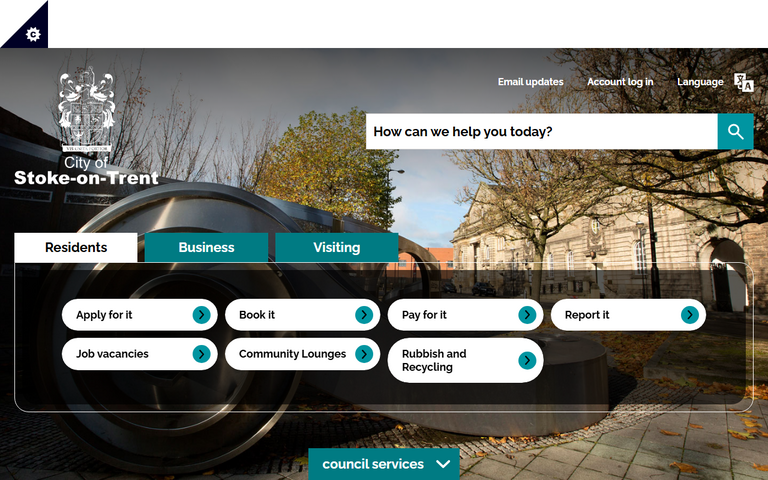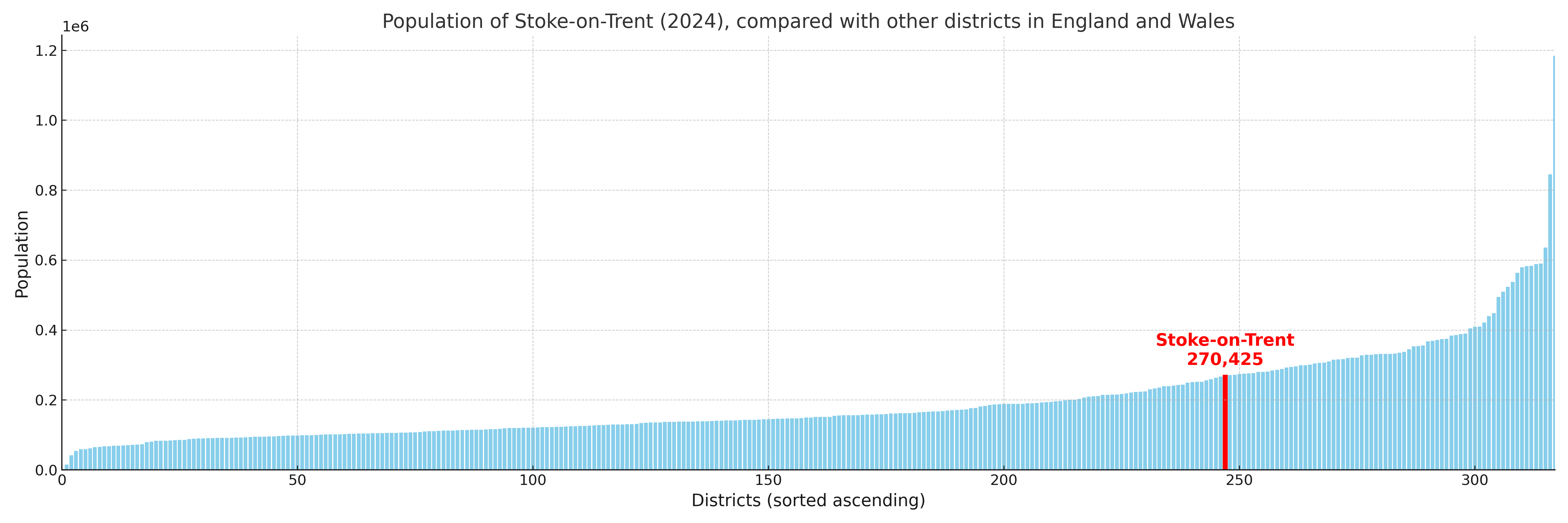Stoke-on-Trent
§ This page gives an overview of the Stoke-on-Trent local authority district, bringing together key facts, maps, and data to help you quickly understand the area. One of 361 district profiles on Baseview.
Overview ⁞ Stoke-on-Trent, in Staffordshire, is known as “The Potteries,” reflecting its world-famous ceramics industry. The city is made up of several towns including Hanley, Burslem, and Longton, each with its own identity. Attractions include the Potteries Museum and Art Gallery, Gladstone Pottery Museum, and canals lined with historic pottery works. The Trent and Mersey Canal runs through, while green spaces like Trentham Gardens and nearby moorland of the Staffordshire Moorlands add natural beauty. The district’s landscape is a mix of industrial heritage, waterways, and surrounding countryside.
Stoke-on-Trent Boundary Map
This map shows the official boundary of the Stoke-on-Trent local authority district, based on the latest geographic data published by the Office for National Statistics (ONS). It provides a clear view of the district’s extent and helps you understand how the area fits within the wider regional and national landscape.
Contains OS data © Crown copyright and database right 2025. Source: Office for National Statistics licensed under the Open Government Licence v3.0.
The administrative boundary of Stoke-on-Trent can also be viewed on OpenStreetMap: District Boundary of Stoke-on-Trent.
Key Facts about Stoke-on-Trent
What region is Stoke-on-Trent in? Stoke-on-Trent is in the West Midlands of England, a region within the UK.
What county is Stoke-on-Trent in? Stoke-on-Trent is in the county of Staffordshire.
Is Stoke-on-Trent a city? Yes, Stoke-on-Trent is a city. Stoke-on-Trent holds official city status as one of the 76 designated cities in the UK.
Who governs Stoke-on-Trent? The local government for this district is: Stoke-on-Trent City Council (Unitary Authority).
▶ Official website of Stoke-on-Trent City Council 🔗 stoke.gov.uk

Which police force covers Stoke-on-Trent? Policing in Stoke-on-Trent is provided by Staffordshire Police 🔗 staffordshire.police.uk, which serves 9 local authority districts: Cannock Chase ⁞ East Staffordshire ⁞ Lichfield ⁞ Newcastle-under-Lyme ⁞ South Staffordshire ⁞ Stafford ⁞ Staffordshire Moorlands ⁞ Stoke-on-Trent ⁞ Tamworth.
Stoke-on-Trent in International Geographies
In the International Territorial Levels (ITLs) hierarchy, Stoke-on-Trent is an ITLs Level 3 area:
- (ITL 1) West Midlands
- (ITL 2) ⇒ Shropshire and Staffordshire
- (ITL 3) ⇒⇒ Stoke-on-Trent
The International Territorial Levels are used by OECD member countries for statistical purposes to classify administrative areas. We have this listable page for easy browsing of ITL names and codes: International Territorial Levels.
Constituencies in Stoke-on-Trent
Stoke-on-Trent is divided into 3 parliamentary constituencies, listed below in alphabetical order.
A constituency is a specific geographical area that elects one Member of Parliament (MP) to represent them in the House of Commons. The United Kingdom is divided into 650 parliamentary constituencies. We have this list page for easy browsing of all UK parliamentary constituencies: List of Constituencies.
Wards in Stoke-on-Trent
Stoke-on-Trent is divided into 34 wards, listed below in alphabetical order.
- Abbey Hulton
- Baddeley, Milton & Norton
- Basford & Hartshill
- Bentilee, Ubberley & Townsend
- Birches Head & Northwood
- Blurton
- Boothen
- Bradeley & Chell Heath
- Bucknall & Eaton Park
- Burslem
- Burslem Park
- Dresden & Florence
- Etruria & Hanley
- Fenton East
- Fenton West & Mount Pleasant
- Ford Green & Smallthorne
- Goldenhill & Sandyford
- Great Chell & Packmoor
- Hanford, Newstead & Trentham
- Hanley Park, Joiner's Square & Shelton
- Hartshill Park & Stoke
- Hollybush
- Lightwood North & Normacot
- Little Chell & Stanfield
- Longton & Meir Hay South
- Meir Hay North, Parkhall & Weston Coyney
- Meir North
- Meir Park
- Meir South
- Moorcroft & Sneyd Green
- Penkhull & Springfields
- Sandford Hill
- Trent Vale & Oak Hill
- Tunstall
In the UK, a ward is a subdivision of a local authority area, used mainly for electoral and statistical purposes. Defined by the ONS, wards represent the primary unit for local elections, each returning one or more councillors to the local council. Wards are also used as a key geography for presenting population and census data.
Parishes in Stoke-on-Trent
Stoke-on-Trent is entirely unparished—there are no civil parishes in this local authority district.
Parishes are the lowest tier of local government; where they don’t exist, those very local services and representation sit directly with the principal council.
Built-up Areas in Stoke-on-Trent
Stoke-on-Trent covers 6 built-up areas, listed below in alphabetical order.
- Blythe Bridge and Forsbrook *
- Brown Edge *
- Harriseahead, Mow Cop and Newchapel *
- Newcastle-under-Lyme *
- Stoke-on-Trent *
- Werrington *
In the UK, a Built-up Area (BUA) is a continuous urban area of at least 20 hectares (0.2 km²), defined by the ONS as land where buildings are generally no more than 200 metres apart, such as towns, cities, or large villages. (Note: A BUA name marked with an asterisk (*) indicates that the area is situated partly in the district of Stoke-on-Trent.)
Stoke-on-Trent compared with other districts in the UK
This section shows how Stoke-on-Trent compares with other local authority districts in the UK, using a variety of measures and rankings.
Stoke-on-Trent has 34 electoral wards.

Stoke-on-Trent has a population of 270,425 (2024 mid-year estimate by ONS)

More local statistics and data for Stoke-on-Trent can be found on the ONS statistics for Stoke-on-Trent.